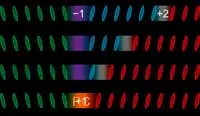 Self-reinforcing solitary wave packets called solitons could achieve a more stable transmission of information, according to scientists at the Centre for Artificial Low Dimensional Electronic Systems (CALDES), within Korea's Institute for Basic Science (IBS). Their experiments and models are said to pave the way to a new field of electronics: solitonics.
Self-reinforcing solitary wave packets called solitons could achieve a more stable transmission of information, according to scientists at the Centre for Artificial Low Dimensional Electronic Systems (CALDES), within Korea's Institute for Basic Science (IBS). Their experiments and models are said to pave the way to a new field of electronics: solitonics.
A similar concept to topology could be used in IT to protect the flow of information from external interferences and impurities and guarantee its stability over longer distances and time. Until now however, the transmitted information was too stable to be modified and used.
One of the key components of the physics of topological system is the soliton, a stable solitary wave packet of energy, which travels though some 1D materials without losing its shape and energy.
The scientists explored the properties of solitons on a double chain of indium atoms placed on the top of a silicon surface and claim to have found that solitons could exist in three forms.
"In a topological sense, it is like having a donut with a lot of holes, where each hole can be of three different shapes corresponding to the three types of solitons," explained researcher Yeom Han Woong.
In this study, the team observed that solitons can be transformed and yet remain immune to the defects of the medium.
"So far solitons could only be created or destroyed in pairs, no other manipulations were possible, but we showed that these solitons can be switched from one to another, and even used for logical operations,” continued Woong.
These three types of solitons can also be represented by digits which can then be used for mathematical computations.
IBS scientists envisage new generation IT devices that combine silicon and solitons. "We are using solitons travelling in indium atoms on a silicon surface, and we imagine that this structure that could be implemented in current silicon devices, creating hybrid systems," concluded researcher Kim Tae-Hwan.
Author
Peggy Lee
Source: www.newelectronics.co.uk

